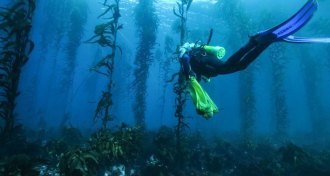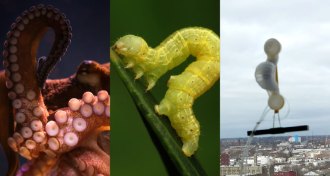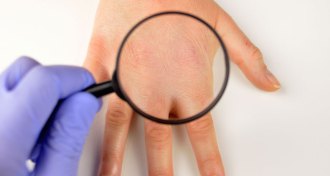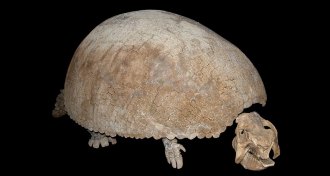All Stories
-
 Oceans
OceansOcean heat waves are becoming more common and lasting longer
Over the last 100 years, the world’s oceans have sweltered through a rising number of heat waves.
-
 Microbes
MicrobesThis material uses energy from ambient light to kill hospital superbugs
A quantum dot–powered material could help reduce the number of hospital-acquired infections, including those with drug-resistant bacteria.
-
 Health & Medicine
Health & MedicineWorld’s hottest pepper may have triggered this man’s severe headaches
A man ate one of the hottest peppers in the world. About a minute later, his head began pounding.
By Dan Garisto -
 Tech
TechA new soft bot mimics octopuses and inchworms to climb walls
A new soft robot that scales walls could help with surveillance or building inspections.
-
 Anthropology
AnthropologyFinger fossil puts people in Arabia at least 86,000 years ago
A desert discovery suggests that Arabia was an ancient human destination.
By Bruce Bower -
 Particle Physics
Particle PhysicsThe search for mysterious dark matter underdogs steps up
Dark matter particles called axions are finally being put to the test.
-
 Health & Medicine
Health & MedicineDelusions of skin infestation may not be so rare
Delusional infestation, an unwavering belief that one’s skin is overrun with creatures or objects, may not be as rare as previously thought, researchers say.
-
 Life
LifeFossils sparked Charles Darwin’s imagination
Darwin’s Fossils recounts how finding extinct species in South America helped Charles Darwin develop his theory of evolution.
By Sid Perkins -
 Tech
TechSheets of tiny bubbles could bring a sense of touch to virtual reality
Shape-shifting films used in sleeves or other garments could provide tactile feedback that makes virtual realities feel more real.
-
 Animals
AnimalsIn a colony, king penguins behave like molecules in a 2-D liquid
Positions of king penguins in a breeding colony resemble molecules in a 2-D liquid.
By Dan Garisto -
 Astronomy
AstronomyDark matter isn’t interacting with itself after all
Hints that a distant galactic collision knocked dark matter askew fizzled with new observations.
-
 Environment
EnvironmentMicroplastics may enter freshwater and soil via compost
Compost is pinpointed as a source of plastic pollution, but environmental fate and effects unknown.